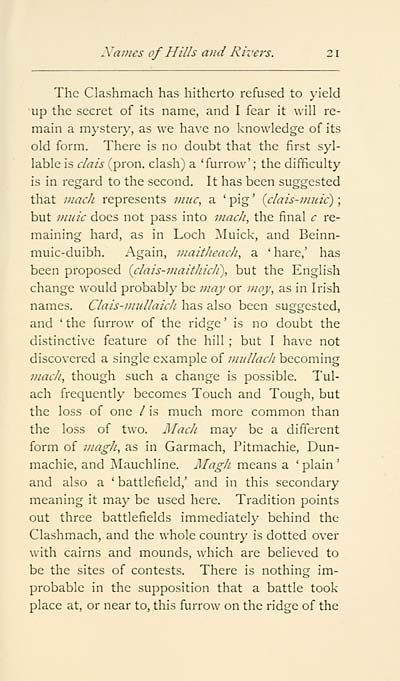Blair Collection > Place names in Strathbogie, with notes historical, antiquarian and descriptive
(41)
Download files
Complete book:
Individual page:
Thumbnail gallery: Grid view | List view

Xai/ies of Hills and Rive is.
The Clashmach has hitherto refused to yield
up the secret of its name, and I fear it will re-
main a myster}-, as we have no knowledge of its
old form. There is no doubt that the first syl-
lable is dais (pron. clash) a 'furrow'; the difficulty
is in regard to the second. It has been suggested
that mack represents inuc, a ' pig ' {clais-miuc) ;
but muic does not pass into viacJi, the final c re-
maining hard, as in Loch ]Muick, and Beinn-
muic-duibh. Again, inaitJieach, a ' hare,' has
been proposed {clais-maitJiidi), but the English
change would probably be may or i)io)\ as in Irish
names. Clais-midlaicJi has also been suggested,
and ' the furrow of the ridge ' is no doubt the
distinctive feature of the hill ; but I have not
discovered a single example of miillach becoming
inadi, though such a change is possible. Tul-
ach frequently becomes Touch and Tough, but
the loss of one / is much more common than
the loss of two. Madi may be a different
form of iiiagh, as in Garmach, Pitmachie, Dun-
machie, and Mauchline. Magh means a ' plain '
and also a ' battlefield,' and in this secondary
meaning it may be used here. Tradition points
out three battlefields immediately behind the
Clashmach, and the whole country is dotted over
with cairns and mounds, which are believed to
be the sites of contests. There is nothing im-
probable in the supposition that a battle took
place at, or near to, this furrow on the ridge of the
The Clashmach has hitherto refused to yield
up the secret of its name, and I fear it will re-
main a myster}-, as we have no knowledge of its
old form. There is no doubt that the first syl-
lable is dais (pron. clash) a 'furrow'; the difficulty
is in regard to the second. It has been suggested
that mack represents inuc, a ' pig ' {clais-miuc) ;
but muic does not pass into viacJi, the final c re-
maining hard, as in Loch ]Muick, and Beinn-
muic-duibh. Again, inaitJieach, a ' hare,' has
been proposed {clais-maitJiidi), but the English
change would probably be may or i)io)\ as in Irish
names. Clais-midlaicJi has also been suggested,
and ' the furrow of the ridge ' is no doubt the
distinctive feature of the hill ; but I have not
discovered a single example of miillach becoming
inadi, though such a change is possible. Tul-
ach frequently becomes Touch and Tough, but
the loss of one / is much more common than
the loss of two. Madi may be a different
form of iiiagh, as in Garmach, Pitmachie, Dun-
machie, and Mauchline. Magh means a ' plain '
and also a ' battlefield,' and in this secondary
meaning it may be used here. Tradition points
out three battlefields immediately behind the
Clashmach, and the whole country is dotted over
with cairns and mounds, which are believed to
be the sites of contests. There is nothing im-
probable in the supposition that a battle took
place at, or near to, this furrow on the ridge of the
Set display mode to: Large image | Transcription
Images and transcriptions on this page, including medium image downloads, may be used under the Creative Commons Attribution 4.0 International Licence unless otherwise stated. ![]()
| Early Gaelic Book Collections > Blair Collection > Place names in Strathbogie, with notes historical, antiquarian and descriptive > (41) |
|---|
| Permanent URL | https://digital.nls.uk/81166838 |
|---|
| Description | A selection of books from a collection of more than 500 titles, mostly on religious and literary topics. Also includes some material dealing with other Celtic languages and societies. Collection created towards the end of the 19th century by Lady Evelyn Stewart Murray. |
|---|
| Description | Selected items from five 'Special and Named Printed Collections'. Includes books in Gaelic and other Celtic languages, works about the Gaels, their languages, literature, culture and history. |
|---|

